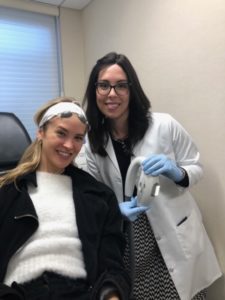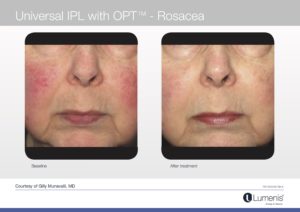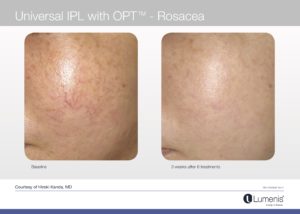If your cheeks have suddenly become red and pimply, and you think you’ve developed acne or an allergy, please don’t try to treat it yourself with over-the-counter lotions and creams. See a dermatologist. You may be one of the 16 million Americans with a chronic facial skin condition called rosacea, and you need to get professional help because it’s not going to go away on its own. You’ll also likely do yourself more harm by playing doctor.
April is Rosacea Awareness Month, so I was pleased to interview Dr. Estee Williams about the disease and effective treatment. A board-certified New York City dermatologist in private practice, and assistant clinical professor of dermatology at Mount Sinai Hospital, Dr. Williams is trained in medical dermatology, skin cancer detection and screening, cosmetic dermatology, injectables (Botox and fillers), lasers, anti-aging procedures, and pediatric dermatology.
FABOVERFIFTY WHAT IS ROSACEA AND WHO IS MOST LIKELY TO GET IT?

DR. WILLIAMS “Rosacea is mostly a facial skin condition of redness and sensitivity that typically affects Caucasian women in their 30s, 40s and 50s (especially those of Northern European descent). It can, however, affect men and people with skin of color, but we don’t see it in children.
“Rosacea almost always affects the cheeks, usually the nose (which may become enlarged and bulbous and may look red, swollen and distorted), and sometimes the chin. It can include flushing and blushing that comes and goes, or it can look like acne with pimples all the time. Some pimples may heal and new ones can form. Patients across the board report that their skin is extremely sensitive, with stinging, itching, burning or a tight feeling. Their skin is dry, red and irritated, and usually not oily. At times active and at other times quiet, rosacea generally is a chronic condition.”
WHAT CAUSES ROSACEA AND WHY ARE 30-TO 60-YEAR-OLD WOMEN MORE AT RISK?
“Rosacea is considered a multifactorial disease, which means it has a number of causes. First, the nerves aren’t properly communicating with the blood vessels in a patient’s skin, and when they inappropriately signal the blood vessels to dilate, it manifests as redness. Second, high levels of inflammation in patients’ skin is believed to link rosacea to other conditions, such as high blood pressure and even migraine headaches. Third, some think that the skin of rosacea patients has a higher level of Demodex, a mite that’s actually on everyone’s skin, although this has become a controversial subject.
“No one knows exactly why women 30 to 60 years old constitute the largest rosacea population, but there’s definitely a hormonal component, and this is when women experience significant hormonal changes. Rosacea tends to quiet down once a patient is around 55 or 60. The same is true for adult onset acne, which usually affects women in their 30s through their 50s.”
DOES ROSACEA AFFECT A PATIENT’S MENTAL STATE?
 “Studies from the National Rosacea Society show that up to 90 percent of patients report they have low self-esteem and low self-confidence due to the condition. It’s not a life-threatening or a dangerous disease, but it can take up a lot of a person’s attention. Imagine if you’re going to an event or on a job interview and have to cover up a very red face or bumps. It can affect your social interactions because that’s what people see.”
“Studies from the National Rosacea Society show that up to 90 percent of patients report they have low self-esteem and low self-confidence due to the condition. It’s not a life-threatening or a dangerous disease, but it can take up a lot of a person’s attention. Imagine if you’re going to an event or on a job interview and have to cover up a very red face or bumps. It can affect your social interactions because that’s what people see.”
HOW IS ROSACEA TREATED AND CAN IT BE PERMANENTLY CURED?
“I enjoy treating this condition because we have therapies that work really well, from the right sunscreen to prescription pills that are FDA approved specifically for Rosacea. The FDA also has approved an antiparasitic cream that kills skin mites.
“I also like to use lasers and IPL (Intense Pulsed Light) Devices, particularly the Lumenis M22. It’s my favorite IPL device, which I use it pretty much on all my rosacea patients who are willing to try it. The treatment is safe and works great.
“Treatments can achieve full clearness of the disease but there’s still always the potential for a flare up. There’s no cure, so patients must continue on treatments.”
PLEASE EXPLAIN HOW THE LUMENIS IPL WORKS ON ROSACEA.
“We first cover the face with a very cold coupling gel to keep a patient comfortable and give her goggles. The Lumenis IPL produces a series of different wavelengths of light that we use to target and heat up the blood vessels, which causes them to spasm and close up. Sometimes, I even see a tiny little blood vessel turn purple in real time, which tells me that the blood inside the vessel has clotted.”
HOW LONG DOES IT TAKE FOR THE ROSACEA TO DISAPPEAR AND HOW MANY TREATMENTS ARE NEEDED?
“It takes a few weeks for patients to see a significant improvement, especially if they’re very red. My most severe patients will come in about every six weeks. Someone with a quieter rosacea can evenly space their treatments throughout the year.
“It also depends on what medicine a patient is taking. Some patients prefer not to take any medications, so the M22 is their only rosacea treatment and they come in more often. Other patients also take pills and use creams, so they don’t have to come in as often, maybe every few months.”
HOW LONG IS EACH TREATMENT?
“Seven to 10 minutes.”
WHY IS THE LUMENIS M22 YOUR FAVORITE IPL DEVICE FOR TREATING ROSACEA?
 “IPL machines aren’t uniform from office to office. I love the M22 because I can crank up the energy and make it stronger, or I can keep it light, depending on the patient’s needs. I can customize the wavelengths of light depending on the redness of the different areas of the skin. Many of my rosacea patients want to go back to work right after their treatments, so I generally won’t go too strong to avoid bruising.
“IPL machines aren’t uniform from office to office. I love the M22 because I can crank up the energy and make it stronger, or I can keep it light, depending on the patient’s needs. I can customize the wavelengths of light depending on the redness of the different areas of the skin. Many of my rosacea patients want to go back to work right after their treatments, so I generally won’t go too strong to avoid bruising.
“I also can use the M22 to remove hair, freckles or sunspots, and for acne scarring. I like the IPL for a full-face treatment because of its other benefits.”
WHAT IS THE COST OF IPL TREATMENTS AND ARE THEY COVERED BY INSURANCE?
“A treatment can be $350 or $400 with a dermatologist in New York, less in other parts of the country. Some insurance covers IPL treatments up to 90 percent. If a patient is on a budget, and her insurance doesn’t cover the treatments, I’ll start with medications and/or creams and see how well it goes. We can add the IPL later.”
CAN ONLY MEDICAL DOCTORS PERFORM IPL TREATMENTS?
“The laws vary from state to state. In some cases it’s not necessary to have a medical background to use an IPL. But you absolutely have to be educated to properly fire the wavelengths of light. You just don’t plug in the settings and flash lights. You also must carefully observe how the patient’s skin is responding during the treatment. These are serious treatments. I have extensive training and I’ve used the IPL on many patients. I do all the treatments myself.”
NEAR YOU!


